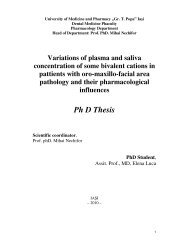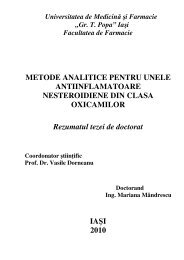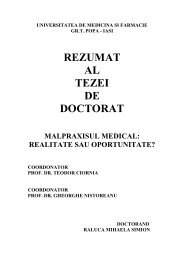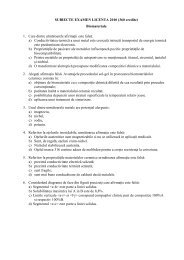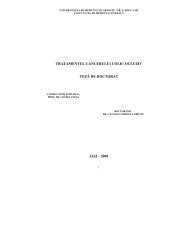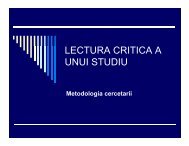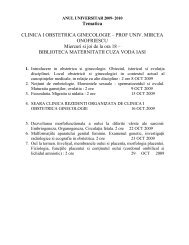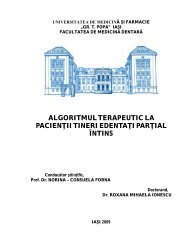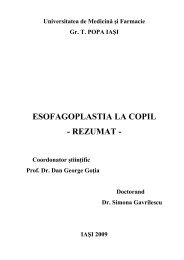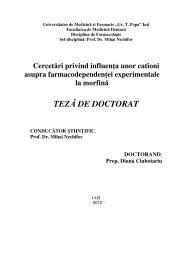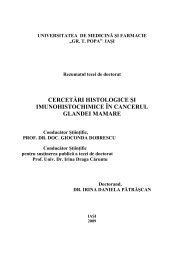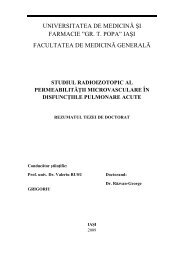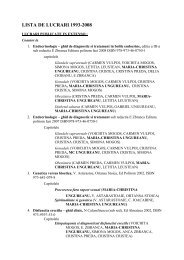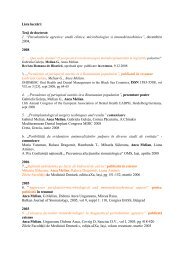prof. dr. neculai ianovici - "Gr.T. Popa" Iasi
prof. dr. neculai ianovici - "Gr.T. Popa" Iasi
prof. dr. neculai ianovici - "Gr.T. Popa" Iasi
Create successful ePaper yourself
Turn your PDF publications into a flip-book with our unique Google optimized e-Paper software.
“GR. T. POPA” UNIVERSITY OF MEDICINE AND PHARMACY IASI<br />
ABSTRACT<br />
FRACTURES OF CERVICAL SPINE<br />
Ph.D. CANDIDATE<br />
BOGRIS ELEFTHERIOS<br />
SCIENTIFIC ADVISOR<br />
PROF. DR. NECULAI IANOVICI<br />
IASI 2010<br />
1
CONTENTS<br />
GENERAL PART<br />
1. INTRODUCTION<br />
2. EPIDEMIOLOGY OF TRAUMATIC CERVICAL INJURIES<br />
3. NOTIONS REGARDING THE ANATOMY OF THE CERVICAL<br />
RACHIS<br />
4. BIOMECHANICS OF THE CERVICAL SPINE<br />
5. CLASSIFICATION OF CERVICAL VERTEBRAL<br />
TRAUMATISMS<br />
6. TREATMENT OF CERVICAL VERTEBRAL TRAUMATISMS<br />
7. CURRENT DEVELOPMENTS IN THE THERAPY WITH STEM<br />
CELLS IN CERVICAL TRAUMATIC INJURIES<br />
PERSONAL CONTRIBUTION<br />
1. CASE AND STATISTICAL STUDY OF PATIENTS WITH<br />
CERVICAL VERTEBRAL TRAUMATISMS<br />
2. ETIOLOGICAL AND EPIDEMIOLOGICAL DATA REGARDING<br />
THE CERVICAL VERTEBRAL TRAUMATISMS BETWEEN 2005<br />
– 2009 IN THE NEUROSURGERY CLINIC FROM IASI<br />
3. DIAGNOSIS ELEMENTS AND ALGORITHMS IN THE<br />
TRAUMATIC INJURIES OF THE CERVICAL RACHIS<br />
4. ELEMENTS AND ALGORITHMS IN THE MEDICAL AND<br />
SURGICAL TREATMENT OF THE CERVICAL RACHIS<br />
5. CONCLUSIONS<br />
6. BIBLIOGRAPHY<br />
2
1. INTRODUCTION<br />
The Romanian society at the end of the 2 nd millennium is marked by deep<br />
modifications in all aspects of life: social, economic, technical, scientific,<br />
ideological and not in the least, medical. The explosive development of<br />
technology, science and the increase of the population, totaling six billion<br />
worldwide, have led to two main aspects. The first one is represented by the<br />
high risk of trauma; the second one by the development of the medical<br />
technique, which, aided by sophisticated means of investigation and<br />
treatment, allows a much better evaluation of the substrate of the injuries.<br />
In this general framework of increase in the frequency of traumatisms, the<br />
vertebro-medullary traumas represent a special category, being among the<br />
worst in traumatic pathology. Morbidity and mortality due to CVMT are<br />
continuously rising making more and more innocent victims and signaling<br />
an increase in the severity of the traumatisms. The traumatic medullar<br />
injuries represent 2% of the deaths following traumatisms.<br />
Cervical vertebro-medullary traumatic injuries are among the most<br />
serious ones in traumatic pathology. There is definitely no other more<br />
<strong>dr</strong>amatic injury than tetraplegy by cervical trauma.<br />
The concept of spinal recovery is based on the rehabilitation techniques<br />
described in 1940 by Sir Ludwig Guttman, in the studies carried out at the<br />
Stoke Mandeville Center in <strong>Gr</strong>eat Britain (Collins). The mortality of 80-90%<br />
of patients with traumatic medullar injuries, caused by the urologic sepsis or<br />
from eschars, was greatly reduced through the use of skeletal traction, the<br />
improvement of the care techniques and the introduction of rehabilitation<br />
programs.<br />
3
2. EPIDEMIOLOGY<br />
VTM represent approximately 1% of the total of traumatisms and around<br />
43% of the pathology of the vertebral spine. The pathology is more often<br />
met in the case of men, aged between 15 and 35. The most frequently<br />
affected spinal segments are: the cervical spine (C6) and the thoraco-lumbar<br />
junction (D12 and L1 vertebrae).<br />
The epidemiology of cervical vertebro-medullary traumatisms studies<br />
the frequency and structure of these injuries, the social and economic impact<br />
they have in modern society.<br />
As far as the anatomic location is concerned, the frequency of the<br />
injuries in descending order would be as follows: C5, C6, C7, C2, C4, C3<br />
and C1 (Arseni and Panoza).<br />
3. NOTIONS OF ANATOMY<br />
The vertebral spine, an organ of axial support providing resistance,<br />
represents a post with a very complex morpho-functional structure and<br />
junction areas of a multitude of cinematic chains. (Arseni and col.).<br />
Inside the cervical spine there are seven vertebrae. A particular<br />
specialization applies in the case of the first two vertebrae, the three middle<br />
ones having specific regional characters while the last two display special<br />
features.<br />
The atlas – is a ring-like bone, the first cervical vertebra. It is formed of<br />
two bony masses called lateral masses, united by two bony arches that<br />
delimitate a large vertebral orifice.<br />
The axis – the main component of the axis, the second cervical spine, is<br />
the odontoid dens. Rising upwards and anteriorly it articulates in a synovial<br />
4
junction with the posterior surface of the anterior arch of the atlas. The<br />
transverse ligament which comprises the odontoid process is the most<br />
important support structure for the atlanto-axial articulation.<br />
The odontoid process is a 15-18mm high pivot, overlapping by a few<br />
millimeters the upper rim of the anterior arch of the atlas.<br />
The typical cervical vertebrae are formed of a body, transverse<br />
processes, posterior arches and pedicles. The relatively small vertebral<br />
bodies have the inner surface slightly larger than the upper one, the size<br />
rising in cranio-caudal direction.<br />
The intervertebral discs are non-homogeneous, elastic particular<br />
structures which distort and ensure motility and stability of the motor<br />
segments of the rachis. The intervertebral discs are situated between the<br />
vertebrae, except the atlanto-axial level. The adult disc is avascular and is<br />
structurally formed of the nucleus pulposus, annulus fibrosis and the two<br />
terminal plates of hyaline cartilage.<br />
The spinal channel closes posteriorly through the posterior arch and the<br />
presence of the yellow ligaments, starting with the space between the C2 and<br />
C3 vertebrae. The elasticity of the yellow ligaments limits flexibility and<br />
ensures cervical lordosis. The anterior plication of the yellow ligaments may<br />
contribute to the apparition of medullar compression symptoms (Howard<br />
and col.).<br />
The neurovascular structures of the cervical spine include: the cervical<br />
segment of the spine, the nerve roots, the carotid and vertebral artery, the<br />
laryngeal nerve, the sympathetic chain, the veins and vessels of the spinal<br />
bone marrow. The spinal bone marrow is the segment of the central nervous<br />
system located in the rachidian channel. It has the shape of a slightly antero-<br />
5
posteriorly bent cylinder with a transversal diameter of approximately 12mm<br />
and the sagittal one of 8-10mm (Petrovanu and col).<br />
The spinal bone marrow is located in the rachidian channel and<br />
communicates with it through the spinal meninges and the peridural space.<br />
The spinal dura mater represents a fibrous cylin<strong>dr</strong>ical tube covering the<br />
marrow, being attached to the circumference of the occipital foramen<br />
magnum. The space between the wall of the vertebral channel and dura<br />
mater is called epidural and contains: adipose tissue filled with spinal nerve<br />
roots and the vessels destined for the marrow, the anterior, lateral and<br />
posterior anchoring meningo vertebral ligaments, the internal vertebral<br />
venous plexus. The epidural space communicates through the intervertebral<br />
holes with the paravertebral spaces.<br />
Although situated closer to the posterior wall of the spinal channel, the<br />
marrow and spinal nerves are most frequently affected by anterior injuries –<br />
fractures or vertebral compression, DIV herniation, tumors. On the<br />
transversal section the spinal marrow appears to be formed of grey matter,<br />
centrally H-shaped distributed and of white peripheral matter.<br />
The white substance is formed of myelinated fibers, glial cells and<br />
blood vessels. It appears under the form of longitudinal columns, forming<br />
ventral, lateral and dorsal medullar columns.<br />
The posterior cord is formed of homolateral fibers of the ascending<br />
gracilis tract (Goll) and cuneatus (Burdach), which transmit conscious<br />
epicritic, fine touch and proprioceptive sensitivity. The lateral cord is formed<br />
of the dorsal spinocerebellar tract (direct, Flechsig) and the ventral<br />
spinocerebellar tract (double cross Gowers) which conveys proprioceptive<br />
sensitivity.<br />
6
The antero-lateral is formed of several tracts. The lateral and ventral<br />
spinothalamic tract that conveys thermal, protopathic, pain and partly tactile<br />
sensitivity. The spinotectal tract, well individualized in the cervical segments<br />
forms one of the means of spinovisual reflexes. The descending pathways<br />
are represented by axons of the neurons from the sensomotor areas of the<br />
cerebral cortex or the nuclei of the brainstem. The lateral corticospinal or<br />
cross pyramidal tract is located in the posterior side of the lateral cord. The<br />
corticospinal ventral or direct pyramidal tract is found in the ventral<br />
homolateral cord. The tectospinal tract ventromedially located in the ventral<br />
cord constitutes the support of the postural reflexes triggered by visual and<br />
auditory stimuli. The rubrospinal tract situated in the functional lateral cord<br />
acts on the tonus of the agonist motoneurons (flexor). The vestibulospinal<br />
tract situated in the lateral region of the ventral cord acts on the extensor<br />
alpha neurons, playing an important role in maintaining the vertical position<br />
of the body.<br />
The major contribution in the vascularization of the spine and of the<br />
cervical spinal cord belongs to the vertebral arteries originating in the<br />
subclavian arteries. The major contribution in the medullar vascularization<br />
belongs to the anterior and posterior spinal arteries.<br />
Anterior microangiographic studies on the marrow described the<br />
plexus: by overlapping the osteodiscal elements and connecting them<br />
through ligaments and muscles an approximately 2cm opening is formed.<br />
This tunnel contains the radicular nerve, the spinal ganglion and the ramus,<br />
anterior of the spinal nerve.<br />
Through the middle of the trajectory formed by the overlapping of the<br />
transversal openings passes the vertebral artery, situated prior to the nerve<br />
ramus and accompanied by a venous plexus and the vertebral nerve.<br />
7
4. THE BIOMECHANICS OF THE CERVICALE SPINE<br />
The cervical spine is subject to various flexing, rotation, extension, vertical<br />
compression or tearing forces which may cause injuries to the bony,<br />
ligamentary, vascular and nerve elements of the spine. The understanding of<br />
the mechanisms of the injuries at the level of the atlanto-occipital region and<br />
that of the upper cervical spine results from the regional anatomical<br />
particularities.<br />
The injury in hyperextension which causes the rupture of alar,<br />
transverse ligaments of the tectorial and cruciform membrane condition an<br />
atlanto-occipital dislocation. Such injuries appear in the case of blows under<br />
the chin followed by cervical hyperextension and result in a posterior<br />
dislocation of the occiput on the CI vertebra.<br />
The blows to the back and head may also cause fractures of the<br />
posterior arch of the atlas or odontoid. The head or neck hyperflexion may<br />
condition or associate a fracture of the anterior arch of the atlas. A particular<br />
injury at this level is the cervicomedullar transaxial injury which appears as<br />
the result of a direct blow in the vertex, without fractures of the skull or the<br />
cervical spine. This results in an immediate cardio respiratory paralysis and<br />
death of the patient due to petechial hemorrhages in the upper region of the<br />
spinal marrow.<br />
The stable and unstable spinal injuries are determined in the context of<br />
the current vertebro-medullar traumatism. If the fractured fragment allows<br />
the possibility of modification of position until recovery, then this fracture is<br />
considered unstable. The fractures where the bone fragments dislocate<br />
8
causing neurological affections during the healing period are also considered<br />
unstable.<br />
For the cervical spine, a vertebral subluxation larger than 3.5mm and an<br />
angulation exceeding 11° indicate a major ligamentary instability.<br />
5. CLASSIFICATION OF CERVICAL VERTEBRAE<br />
TRAUMATISMS<br />
In the present literature there is no universally accepted classification of<br />
the cervical vertebro-medullar traumatisms (cervical spine injury - in Anglo-<br />
Saxon literature). According to Putti quoted by Arseni and col., there are two<br />
major groups from the point of view of the injuries:<br />
1. Rachidian injuries affecting the elements of the rachidian channel<br />
called “myelic”;<br />
2. Rachidian injuries without neurological symptoms or “amyelic”.<br />
Frankel and col. Quoted by Vale and col. elaborated a classification of<br />
the neurological deficit associated to vertebro-medullar traumatisms which<br />
proves to be very useful in evaluating the evolution of the neurological<br />
impairments:<br />
Degree A – total absence of motility and sensitivity;<br />
Degree B – absence of motility with preservation of sensitivity;<br />
Degree C – intact motor functions but functionally useless;<br />
Degree D – good motor power, useful;<br />
Degree E - neurological absent deficit.<br />
The fractures of the occipital condyles are isolated or may be<br />
associated with injuries of the odontoid and the atlanto-occipital<br />
complex. They are frequently associated with major neurological<br />
9
affections such as ventilation dependent tetraplegy and dysfunctions<br />
of the cranio-caudal nerves.<br />
The atlanto-occipital dislocation is probably caused by forces in<br />
hyperextension or hyperflexation. This injury represents an anterior or<br />
posterior subluxation or dislocation of the skull in relation to the upper<br />
cervical spine.<br />
The fractures of the atlas constitute approximately 3 – 13% of the<br />
injuries of the cervical spine and are associated by neurological dysfunctions<br />
in 53% of the cases. These fractures are frequently associated with the<br />
fracture of the axis and of the occipital condyles. At this level there are four<br />
types of fractures: fractures of the posterior arch, fractures of the lateral<br />
masses, the Jefferson fracture and the horizontal fracture of the atlas.<br />
6. TREATMENT OF TRAUMATIC INJURIES OF THE CERVICAL<br />
RACHIS<br />
10
The protocol of the treatment of the acute medullar traumatic injury<br />
systematizes the data shown above (illustration cf. Vale F. L. and col.).<br />
The study of the complex medical and surgical treatment of CVTM<br />
cannot be complete without the analysis of possible complications.<br />
The gastrointestinal hemorrhages usually appear in the case of<br />
tetraplegic patients. According to Bohlman, these complications appeared in<br />
41% of the cases treated with steroids and only in 9% of the lot who were<br />
not prescribed this medication.<br />
Pulmonary embolism has a low incidence according to the same author<br />
and requires prophylactic mechanical and pharmacological measures.<br />
The “halo” type immobilization has a complication rate of<br />
approximately 12-27%. The most frequent complications include:<br />
suppurations of soft tissue around skull fixing screws, eschars at the level of<br />
the plate, loosening of the fixture of the skull ring.<br />
A special category is formed by patients with ankylopoetic spondylitis<br />
and traumatisms in hyperextension. At these patients, the complications are<br />
related to the absence of reducible major ligamentary injuries and of massive<br />
epidural hemorrhage met, according to Bohlman, at approximately half of<br />
the total number of patients.<br />
The direct introduction of bacteria during the surgical intervention may<br />
cause suppurations of the cervical spine. The perforations of the esophagus<br />
during anterior approach may lead to esophageal and nasogastric fistulas and<br />
long term medication with antibiotics – up to three months – may cure the<br />
problem.<br />
Although extremely rare, the injuries of the carotid and vertebral<br />
arteries may be fatal. The dilacerations of the carotid artery require prompt<br />
vascular suture.<br />
12
Another complication is the cerebral vascular stroke following arterial<br />
thrombosis. Prophylaxis indicates the periodical suppression of traction on<br />
the vascular wall.<br />
The hypoglossal, upper larynx and recurrent nerve are most frequently<br />
injured during the anterior approach. Knowledge of regional anatomy is<br />
mandatory.<br />
The medullar injury and dural fistulas are produced during corpectomy<br />
due to sudden movements or due to enlargement of a partial rupture of the<br />
LLP in view of inspecting the spinal channel for free bony or discal<br />
fragments.<br />
Pseudarthrosis roza is another complication of anterior cervical fusion.<br />
Usually it is asymptomatic and does not require treatment.<br />
Later complications include instability, persistent medullar<br />
compression, progressive degeneration of neurological functions and<br />
pseudarthroses or instability on different other levels.<br />
The early identification of the cervical traumatic injuries and the<br />
appropriate medical and surgical treatment may diminish the number of<br />
subsequent complications.<br />
7. ACTUALITIES IN THE THERAPY WITH STEM CELLS IN<br />
CERVICAL VERTEBRAL TRAUMATIC INJURIES<br />
The initial mechanic treatment is followed by a cascade of biochemical<br />
and cellular reactions which cause the extension of the death of nerve cells,<br />
interruption and demyelinization of nerve fibers and induce the apparition of<br />
an inflammatory response.<br />
13
The area of medullar injury sometimes extends to several segments above<br />
and below the initial injury, during the following days and weeks.<br />
These secondary injuries have a cumulative effect and increase the<br />
volume of the medullar injury; later, the glial cells start forming the glial<br />
scar which becomes a barrier that prevents the possible recovery and axon<br />
reconnection.<br />
Christian A. Mueller and col. proved the important role of IL-16 in the<br />
immediate post-injury immune response, intervening in the recruitment and<br />
activation of immune cells, triggering the process of obstruction at the level<br />
of microcirculation, the progression of secondary injuries. The authors used<br />
male rats aged between 8 and 12 weeks to whom they caused medullar<br />
injuries then divided them in groups of 5 and euthanized them 1, 3, 7, 14 or<br />
30 weeks after the injuries.<br />
→ the specificity of antibodies IL-16 in the spinal tissue is confirmed by the<br />
selective inhibition of discoloration after pre-incubation for 3 hours in ice<br />
with an excess of peptides IL-16, while the addition of an irrelevant<br />
recombined control peptide (AIF-1) did not block discoloration.<br />
→ immunoreactivity IL-16 is detected in most neurons;<br />
→ only few IL-16 cells are detected in the Virchow-Robin-like spaces<br />
adjacent to the blood vessels, while the neurons of dorsal ganglions prove a<br />
positive reaction to IL-16<br />
→ in comparison with the control medullar sections, after the injury of the<br />
central system there is an accumulation of microglia and macrophage<br />
without neurotic injuries in the close vicinity of the peri-injuries – they<br />
represent regions where secondary injuries characterized by a morphological<br />
structure of amoebaean microglia are developed;<br />
14
→ 3 days after the injury a new subpopulation of microglia/macrophage IL-<br />
16 cells may be noticed, which contain multivacuolar cytoplasm and large<br />
eccentric nuclei;<br />
→ in the central system there is an increase in the number of IL-16 cells up<br />
to perivascular accumulations, perivasculary located;<br />
→ IL-16 cells coexist with the expression of ED1, OX-6 or OX-8 antigens;<br />
→ coexpression of IL-16 and GFAP (glial fibrillary acidic protein) and<br />
MBP (myelin basic protein) in the pannecrotic region, in the controlateral<br />
region GFAP and MBP not being coexpressed;<br />
→ more than 70% of perivascular IL-16 and 20% of parenchymatic are<br />
coexpressed with antigens W3/13 and are recognized as T lymphocytes,<br />
some OX-22 lymphocytes are observed in the perivascular spaces;<br />
→ 3 days after the injury, a low number of microglia/macrophage IL-16<br />
coexpress MIB-5, cells whose existence is restrained to the perilocal area.<br />
Sabine Conrad and col. conducted a study on rats to determine the<br />
<strong>prof</strong>ibrotic and agiogenic role of CTGF (connective tissue growth factor)<br />
within the glial scar (composed of astroglioses and extracellular matrix<br />
deposits, factors which inhibit axon regeneration). The authors used<br />
immunohistochemistry and fluorescence tests and investigated the degree of<br />
CTGF expression during maturation of glial scar on a period between 1 day<br />
and 30 days after the injury. The researchers used rats to which medullar<br />
injuries were induced, only part of them being operated after the injury, the<br />
rest being used to observe the evolution of the injury.<br />
15
PERSONAL CONTRIBUTION<br />
1. STATISTIC AND CASE STUDY OF PATIENTS WITH<br />
CERVICAL VERTEBRAL TRAUMATISMS<br />
I chose for study the time span of 5 years, 2005 – 2009, due to the fact<br />
that, applying for a PhD degree at the Clinic of Neurology from <strong>Iasi</strong>, during<br />
this period I had the opportunity to participate directly to the treatment of<br />
this category of patients and to monitor their evolution.<br />
The lot of patients under investigation comprised a large age span,<br />
between 20 and 80 years old. The method used was mixed, retrospective and<br />
prospective, using the observation sheets of the patients from the archive of<br />
the Clinic of Neurosurgery from <strong>Iasi</strong>.<br />
The paper attempts to take into consideration two aspects, to the<br />
maximum extent possible: one that comprises the analysis of all TVMC<br />
admitted in hospital between 2005 and 2009 and another one destined only<br />
to the study of fractures – cervical luxations, due to the differences that exist<br />
with regards to the clinic and therapy. In order to analyze the long-term<br />
prognosis for patients with TVMC, I conceived a questionnaire that was sent<br />
to the patients’ ad<strong>dr</strong>esses. The number of replies from the patients was<br />
nevertheless small, therefore I wasn’t able to make representative lots for a<br />
statistical study.<br />
Material and statistic method<br />
The method of comparing the same phenomenon between different<br />
categories of patients (differentiated by certain criteria, such as: age groups,<br />
16
diagnosis, risk factors, etc.) constitutes a particularly important aspect in the<br />
understanding of the phenomena.<br />
A series of mathematical methods were used in this study,<br />
implemented in the software used for data management, methods that<br />
characterize the “normal” average values of the studied phenomena, or the<br />
dispersion and average error against these values, prognosis methods, etc.<br />
The statistic indicators calculated in the survey allow generalization,<br />
facilitating comparative and correlative interpretation of different subgroups<br />
of the investigated lot, allowing thus to extrapolate the synthesis from<br />
individual characteristics to group characteristics and later to the whole lot.<br />
2. ETIOLOGICAL AND EPIDEMIOLOGICAL DATA REGARDING<br />
CERVICAL VERTEBRAL TRAUMATISMS BETWEEN 2005-2009<br />
IN THE NEUROSURGERY CLINIC FROM IASI<br />
The horse-carriage falls (40.7%) take the first place in the etiology of<br />
FLC, followed by the falls from heights with 28.2%, traffic accidents -<br />
12.7%, falls from the same level, with 9.3%, water diving (5.4%) and other<br />
causes (3.7%).<br />
17
Fig. 25. Repartition of cases on mechanisms of production of traumatisms<br />
Fig. 26. Repartition of cases on mechanisms of production of traumatisms<br />
and occurrence environments<br />
18
The differences in the causes of production of FLC are better outlined<br />
in the study of these causes according to their place of occurrence.<br />
We would like to examine as well the possible influences of the<br />
patients’ gender on the causes of production of FLC. As can be seen in ( fig.<br />
27) in the case of men the most frequent cause for FLC is represented by the<br />
falls from horse-carriages, followed by the falls from heights and traffic<br />
accidents. In the case of women, the first two causes of production of FLC<br />
are the same, except that the traffic accidents, which come third, are equal in<br />
frequency with the falls from the same height – specific to domestic<br />
accidents.<br />
The Chi-square test does not indicate significant statistic differences<br />
between genders with regards to the production cause of FLC.<br />
Fig. 27. Repartition of cases on mechanisms of production of traumatisms<br />
and genders<br />
19
3. ELEMENTS AND DIAGNOSIS ALGORITHMS IN THE<br />
TRAUMATIC INJURIES OF THE CERVICAL RACHIS<br />
The establishment of the diagnosis was made as a rule with<br />
observance of certain consecutive steps: traumatism anamnesis, the presence<br />
of a facial or skull trauma mark, clinical and neurological exam and finally<br />
paraclinical investigations.<br />
Bilateral luxations (51.7%) represent the main type of injuries at<br />
patients with FLC, the percentage of their identification in our study lot<br />
confirming the data published by Alday and col. (1993), who indicate a<br />
proportion of over 40%. Unilateral luxations represent by their frequency<br />
(14.7%) the second type of injuries encountered in the studied series. The<br />
cominutive and compression fractures of vertebrae with subluxations,<br />
although more rarely encountered (9.3%), are in agreement with the<br />
proportion of 8% published by the above mentioned author. The “tear-<strong>dr</strong>op”<br />
type fracture (6.2% of the cases) is part of a larger group of injuries through<br />
compression in flexion encountered in a proportion of 22%. To the group of<br />
injuries through compression in extension, in proportion of 24% published<br />
by the same author, belong the fractures of articular apophysis with<br />
dislocation (3.1% in our lot) as well as the vertebral fracture with dislocation<br />
(4.0%).<br />
In the case of unilateral dislocations, the neurological deficit most<br />
frequently associated was represented by particular syn<strong>dr</strong>omes (23 cases)<br />
and radicular (9 cases). In the bilateral dislocations, the medullar trans-<br />
section (105 cases) was dominant as well as particular syn<strong>dr</strong>omes (45 cases).<br />
The fracture of articular apophyses with dislocation (only 11 cases) was<br />
20
accompanied by radicular syn<strong>dr</strong>ome (4 cases) or did not determine any<br />
neurological dysfunctions. The cominutive compressions with subluxations<br />
were associated in most cases with particular syn<strong>dr</strong>omes (19 cases) or<br />
radicular (7 cases). All the “tear-<strong>dr</strong>op” like fractures provoked a syn<strong>dr</strong>ome<br />
of medullar trans-section (22 cases). The “hangman’s” fracture either<br />
evaluated without neurological deficit (10 out of 17 cases) or, in the rest of<br />
the cases, determined a radicular syn<strong>dr</strong>ome (7 cases). The odontoid fracture<br />
with dislocation in most cases (8 cases) did not determine a neurological<br />
deficit; in the other cases it caused a neurological deficit in a varying degree,<br />
ranging from complete deficit (in 5 cases) to the radicular syn<strong>dr</strong>ome (5 cases<br />
as well). Finally, the mixed vertebral body fracture, highly neurogenic,<br />
associates in 9 out of 14 cases a complete neurological deficit.<br />
I have also studied a possible association between the types of<br />
vertebral injury and the patients’ sex (fig. 49). No significant differences<br />
were identified statistically between males and females, the situation being<br />
similar with the repartition of the cases in the global lot.<br />
21
Fig.49. Repartition of cases on types of cervical vertebral injury and sex (%)<br />
At very young ages (20 – 30 years) the most frequent type of injury was<br />
represented by the compressed/cominutive fracture with subluxations (25%<br />
of the cases). At ages over 31, the most frequent type of injury is the<br />
bilateral dislocation, generating complete neurological deficit, followed by<br />
the unilateral dislocation. It should also be noticed the percentage of<br />
odontoid fractures with dislocation (10.2%) which represents the third type<br />
of injury in frequency for ages 31-40.<br />
22
4. ELEMENTS AND ALGORITHMS IN THE MEDICAL AND<br />
SURGICAL TREATMENT OF TRAUMATIC INJURIES OF THE<br />
CERVICAL RACHIS<br />
Medical treatment was used in all cases. In cases with minor<br />
(radicular) neurological deficits or in their absence the treatment was<br />
symptomatic. Antalgics, sedatives and sometimes decontracting medicine<br />
were used for all patients. For all 151 patients with complete neurological<br />
deficit the medical treatment was far more complex. Arterial hypotension<br />
under 85 mmHg, registered in 25 cases required the administration of<br />
hy<strong>dr</strong>oelectrolytic solutions (fig. 50). The solutions used were either<br />
physiological serum (12 cases) or glucose serum 5% or 10% (8 cases). In<br />
cases of severe hypotension (5 cases) macromolecular solutions of the type<br />
of dextran and dopamine. The quantity of perfusions in an average of 50 to<br />
60 ml/Kgc/day varied in proportion to the recovery of the arterial tension<br />
and the volume of daily diuresis.<br />
Fig. 50. Administration of hy<strong>dr</strong>oelectrolytic solutions: no. of cases<br />
Corticotherapy and diuretics were also prescribed to all patients with<br />
complete neurological defect.<br />
23
The therapy with antibiotics was a therapeutic measure used<br />
constantly for all patients with complete neurological defect and for those<br />
who suffered surgery.<br />
Gypsum apparatus of “minerva” type were applied to patients from<br />
the studied lot especially for supplementary stabilization post-surgery in 72<br />
cases. In other 39 cases, the gypsum minerva was applied in the following<br />
types of vertebral injuries: for 17 patients with vertebral compressions and<br />
subluxations, for 11 odontoid fractures with moderate dislocation, for 8<br />
“hangman’s” type fractures and for 3 patients who refused surgery.<br />
From the lot of patients under study, 192 (54.24%) benefited only<br />
from medical treatment while the rest (45.76%) also received surgical<br />
treatment.<br />
Surgical treatment<br />
162 patients received surgical treatment, namely 45.76% of the total<br />
patients studied. The surgical intervention was made to the purpose of<br />
reduction, decompression and stabilization.<br />
The most frequent surgeries were conducted to solve a bilateral<br />
luxation, in 54.3% of cases. Unilateral dislocation take the second place,<br />
with 13.6% of the cases, followed closely by compressed or cominutive<br />
fractures associated with luxations (13.0%). The surgical interventions for<br />
the other types of injuries were rarer, approximately for 3 to 5% of the cases<br />
under study. It is therefore to be noticed that surgical treatment was<br />
conducted more frequently for patients with neurological deficit of Degree C<br />
(86.4% of the total cases).<br />
I have also analyzed the extent to which the patients’ age influences<br />
significantly surgical intervention. It is to be noticed that the number of<br />
24
surgical interventions varies significantly from one age group to another (χ 2<br />
= 53.333, p = 0.000, SS), as we shall detail below.<br />
It is to be noticed that if for ages between 20 and 30 only 37.5% of the<br />
cases received surgery, for the other age groups, up to 70 years, surgery was<br />
used in over 40% of the cases. Only for older ages, over 70, the number of<br />
surgical interventions decreased to 24% of the admitted cases.<br />
5. CONCLUSIONS<br />
1. Cervical vertebro-medullar traumatisms are quite frequent and<br />
represent 1.6% of the total of patients admitted in the Clinic of Neurosurgery<br />
<strong>Iasi</strong> in 4 years. Among them, the cervical fractures – luxations which make<br />
the object of this study represent 23.9%.<br />
2. The cervical spine with its constituents shows a series of anatomical<br />
particularities which make it more vulnerable to traumatic aggressions,<br />
conditioning prominence within the general framework of vertebral<br />
traumatisms.<br />
3. The incidence of TVMC for the Moldavian region within the period of<br />
time studied is of 4 to 100.000 people, being extremely close if not identical<br />
to the data found in the specialty literature.<br />
4. There are significant differences in the geographic repartition of the<br />
number of patients with FLC, thus the <strong>Iasi</strong> County has a proportion of<br />
30.7%.<br />
5. The male sex is more affected than the female sex, the F/M proportion<br />
obtained in the studied lot being of 1/6. At the same time, men aged over 60<br />
25
are even more frequently affected, the F/M relation being unfavorable for<br />
the latter, of 1/9.<br />
6. The age group 41-60 is the most affected by the cervical fractures –<br />
luxations (40%), followed by the group over 60 (35.7%) and the 21-40<br />
group (20.9%).<br />
7. The etiology of the cervical fractures – luxations outlines as a primary<br />
cause the falls from horse-carriages (43.4%). The falls from heights,<br />
domestic accidents and in agricultural labor constitute 31.7%.<br />
8. The analysis of the etiology in relation to age shows that the main<br />
causes follow a specific distribution. Thus with chil<strong>dr</strong>en and adolescents, the<br />
falls from heights come first, followed by water diving, with the same<br />
frequency of 42.9%. Young adults (21-40) suffer more frequently in the case<br />
of falls from heights (41.9%) and traffic accidents (34.9%). The falls from<br />
carriages come first for the age groups 41-60 (52.4%) and over 60 (53.5%).<br />
9. The variation of the etiological incidence in relation to <strong>prof</strong>ession<br />
shows that public officials suffer mainly accidents following traffic incidents<br />
(58.3%), workers are mostly affected by falls from heights (50%), farmers<br />
and retired people by falls from horse-carriages (83.3% and 47.9%) and<br />
pupils suffered equally from traffic accidents and falls from heights,<br />
followed by water diving.<br />
10. The seasonal variation in the number of patients with cervical<br />
fractures – luxations shows that during summer and autumn, when<br />
agricultural works is dominant in the population’s activity they cause the<br />
most frequent traumatisms, along with traffic accidents (75.5%).<br />
11. The neurological deficit which conditions the seriousness of<br />
traumatisms measured using the Frankel scale shows the following<br />
distribution: Degree A (complete deficit) – 44.9%, Degree B (incomplete) –<br />
26
8,8%, Degree C (incomplete) – 20.5%, Degree D (incomplete) – 16.1% and<br />
Degree E (absent deficit) – 9.7%.<br />
12. The analysis of the neurological syn<strong>dr</strong>omes appeared in the case of<br />
FLC shows on the first place the syn<strong>dr</strong>ome of medullar trans-section<br />
(44.9%), followed by particular syn<strong>dr</strong>omes (21.5%) and radicular ones<br />
(14.6%). The centromedullar syn<strong>dr</strong>ome (7.3%), acute anterior syn<strong>dr</strong>ome<br />
(1.5%) and Brown-Sequard (0.5%) have a generally low incidence.<br />
13. The vertebral level the most affected was C5 – C6, followed in order<br />
by C6-C7 (32.7%), C4-C5 (16.6%), C1-C3 (10.8%), C3-C4 (2.4%) and C7-<br />
T1 (1.9%).<br />
14. Vertebral injury types within FLC with determining influence in the<br />
seriousness of the medullar injury had the following distribution in<br />
decreasing frequency order: bilateral dislocation – 52.2%; unilateral<br />
dislocation – 16.1%; vertebral fracture with subluxation – 7.3%; ontoid<br />
fracture with dislocation – 6.3%; „tear-<strong>dr</strong>op” type fracture – 5.4%;<br />
„hangman’s” fracture – 4.4%; articulation fracture with dislocation – 3.4%;<br />
mixed vertebral fractures with dislocation – 2.9%.<br />
15. The incidence of the neurological deficit varies in relation to the type<br />
of vertebral injury. Thus, the FLC are extremely neurogenic injuries.<br />
16. The type of vertebral injury determines the incidence of the<br />
neurological syn<strong>dr</strong>ome as follows: unilateral dislocation associates most<br />
frequently particular syn<strong>dr</strong>omes (36.4%) and radicular (30.2%); bilateral<br />
dislocation is dominated by medullar trans-section (61,3%) and particular<br />
syn<strong>dr</strong>omes (19.8%); the articulation fracture with dislocation was mostly<br />
accompanied by radicular syn<strong>dr</strong>ome (57.1%) and in 28.6% of the cases no<br />
neurological dysfunctions were present; the compressions with dislocations<br />
in most of the cases of particular syn<strong>dr</strong>omes (49%) and radicular (33.3%);<br />
27
18. The positive diagnosis was based on record data attesting the<br />
traumatisms and the production mechanisms, the local examination, the<br />
evidencing of skull trauma and head configuration, the objective clinical<br />
exam and the paraclinical examinations.<br />
19. The medical treatment was used in all cases, playing a dominant role<br />
in the patients with complete neurological deficit or as adjuvant of surgical<br />
therapy.<br />
20. The medical treatment applied in the first 8 hours from the<br />
traumatism in the case of patients with complete neurological defect may<br />
contribute to the improvement of the functional diagnosis according to the<br />
NASCIS 3current recommendations.<br />
21. The initial vertebral stabilization is an important moment in the<br />
realization of vertebral realignment which creates favorable conditions for<br />
nerve recovery and prevents secondary radiculo-medullar injuries to a<br />
vertebral instability.<br />
22. The surgical treatment was used for 44.9% of the persons in this<br />
study, aiming at reducing, decompressing and stabilizing the injury region.<br />
The injury types for which surgery was used were: bilateral dislocation<br />
(50%), vertebral body with dislocation (16.3%), unilateral dislocation<br />
(15.2%), odontoid fracture and the mixed body fracture, of 5.4%, „tear-<br />
<strong>dr</strong>op” and „hangman’s” fractures of 3.3% and the articulation fracture with<br />
dislocation (1.1%).<br />
23. Surgical interventions were applied more frequently for patients with<br />
incomplete neurological deficit (68.8%), to those without neurological<br />
phenomena (65%) and only in 16,3% of the cases of complete neurological<br />
deficit. Meanwhile, the vast majority (97.8%) of surgical interventions were<br />
carried out 72 hours after the accident, averaging 12.5 days.<br />
28
REFERENCES<br />
1. Adam D. – Subiecte de neurochirurgie, Ed. Medexim, Bucureşti,<br />
1992<br />
2. Albu I., Radu G., Anatomie topografică, Editura ALL, Bucuresti,<br />
1994<br />
3. Aldea H. şi col. Curs de Neurochirurgie – 2003<br />
4. Aldea H., Ianovici N., Turliuc Dana – Curs de neurochirurgie, Ed.<br />
Dosoftei, Iaşi, 1999.<br />
5. An<strong>dr</strong>onescu A., Anatomia copilului, Editura Didactică si<br />
Pedagogică.1987<br />
6. Aldescu Corneliu – Neuroradiodiagnostic – Editura Junimea, Iaşi,<br />
1982<br />
7. Aldescu Corneliu – Radiologie pentru studenti şi medici stomatologi<br />
– Editura Polirom 1999<br />
8. Alexa O., Stratan L. Notiuni de bază în ortopedie si traumatologie,<br />
sub coordonarea Prof. Dr.Georgescu, 1999<br />
9. Ardavan Akhavan, et al. Pilot Evaluation of Functional<br />
Questionnaire for Predicting Ability of Patients With Tetraplegia to<br />
Self-Catheterize After Continent Diversion. J Spinal Cord Med.<br />
2007<br />
10. Arseni C. Afectiunile neurochirurgicale ale sugarului şi copilului<br />
mic, Ed. Medicala 1979<br />
11. Ashton IK, Roberts S, Jaffray DC. Neuropeptides in the human<br />
intervertebral disc.J Orthop Res 1994<br />
12. Bajenaru O, Pop T - Orbita. In: Rezonanta Magnetica Nucleara in<br />
diagnosticul clinic, sub red. Pop T, Ed. Medicala, Bucuresti, 1995.<br />
29
13. Benson Michael, Fixen John, Machichol Malcolm, Parsch Klaus,<br />
Chil<strong>dr</strong>ens Orthopaedics andFractures, Second Edition, 2002, 230-<br />
231<br />
14. Bensahel H., Orthopedie Pediatrique, a 3e Edition Masson, Paris,<br />
1987<br />
15. Bergoin M., Miramand Y., Allal I., Critéres de Decision et Résultat<br />
du Traitement Orthopedique des Scolioses Idiopathiques de Moins<br />
de 30o, 1984<br />
16. .BISSCHOP G et coll L'hypotonie paraspinalesegmentaire. Congrès<br />
du Gieda-inter-RachisMarseille décembre 2000<br />
17. . Bőrger-Wagner A., Réeducation and Orthopedic Pediatrique, Ed.<br />
Masson, Paris, 1991<br />
18. Braddom, Randal, Physical Medecine and Rehabilitation, 3rd ed.,<br />
Sounders Elsevier, 2007<br />
19. Bogousslavsky J. ,Leger Jean-Marc,- Interpretation des Examens<br />
20. Complementaires en Neurologie , <strong>Gr</strong>oupe Liaisons 2000<br />
21. .Bono CM et al. Measurement techniques for lower cervical spine<br />
injuries: consensus statement of the Spine Trauma Study <strong>Gr</strong>oup.<br />
Spine 2006<br />
22. Bourjat P, Veillon F - Pathologie oculo-orbitaire-TDM et IRM. In:<br />
Imagerie radiologique tête et cou, Paris, Ed. Vigot, 1995.<br />
23. Braun C. M . J. Neuropsychologie du développement. Médecine-<br />
Sciences Flammarion 2000<br />
24. Bullock R., Chesnut R.M., Clifton G. : Guidelenes for the<br />
management of severe head and neck injury. The brain trauma<br />
foundation, New York, AANS, and the Joint Section of<br />
Neurotrauma and Critical Care, 1995<br />
30
25. Burger PC. Surgical Pathology of the Nervous System and its<br />
Coverings. 4 th ed. New York: Churchill-Livingstone; 2002<br />
26. Burlibasa C.,Canavea I.,Ceobanu E.-Elemente de practica in terapia<br />
traumatismelor asociate maxilo-faciale şi cranio cerebrale ,1987<br />
27. Canale S. T., Beaty H. J., Operative Paediatric Orthopaedics, Mosby<br />
Second Edition, 1995<br />
28. Catz A et al. A multi-center international study on the spinal cord<br />
independence measure, version III: Rasch psychometric validation.<br />
Spinal Cord 2006<br />
29. Cavezian R.,Cabanis E.,-Imagerie par resonance magnetique,1986<br />
30. CHILDS JD, Fritz JM, Flynn TW, Irrgang JJJohnson KK,<br />
Majkowski GR, Delitto A. A clinicalprediction rule to identify<br />
patients with low backpain who will benefit from spinal<br />
manipulation: A validation study. Ann Int Med. 2004<br />
31. Ciobanu G.,Mihailovici L. , Ghid practic de tehnica radiologica<br />
cranio-faciala ,Editura Facla,1986<br />
32. Ciurea A.V., Constantinovici A. – Ghid Practic de Neurochirurgie,<br />
Editura Medicala 1998<br />
33. Cocke EW Jr, Robertson JH, Robertson JT, et al. Head Neck Surg.<br />
1990<br />
34. Crutchfield J S, Narayan R. K., Robertson C.S.: Evaluation of the<br />
fiber optic intracranial pressure monitor. J.Neurosurg.<br />
35. Damasio A.R. L’erreur de Descartes. Edition Odile Jacob. 1999 DE<br />
MAUROY JC <strong>Gr</strong>and appareillage deslombalgiques. Res Europ<br />
Rachis 2005<br />
36. Doyon D. , Cabanis E.A. , Frija J. - Imagerie par resonance<br />
magnetique , Masson , 1994<br />
31
37. Dupui Ph. Cours DIU posture Toulouse janvier 200122.<br />
Enciclopedia Encarta- Microsoft, Reference Library 2002<br />
38. ERNST E, Canter PH A systematic review of spinal manipulation.<br />
JR Soc Med.2006<br />
39. Fairbank J. Randomized controlled trials in the surgical management<br />
of spinal problems.Spine 1999<br />
40. FRYMOYER JW et coll An overview of the incidences and cost of<br />
low-back pain. Orthop clinNorth Am 1991<br />
41. Finnerup NB et al. Intraveneous lidocaine relieves spinal cord injury<br />
pain. Anesthesiol 2005<br />
42. Frasin Gh. ,Cozma N -Anatomia Capului şi a Gatului – curs – UMF<br />
Iaşi 1978<br />
43. Gopinath S.P., Robertson C.S.: Clinical evaluation of a miniature<br />
strain gauge transductor for monitoring intracranial pressure,<br />
Neurosurgery 1995. Guiton & Hall, Texbook of Medical<br />
Physiology, 8th Edition, W. B. Saunders Company,Philadelphia,<br />
1991<br />
44. Gotia D.G., Chirurgie, ortopedie si traumatologie clinică,<br />
Universitatea de Medicină si Farmacie “<strong>Gr</strong>. T. Popa”, <strong>Iasi</strong>, 1996<br />
45. Gotia D.G., Aprodu G.S., Gavrilescu S., Savu B., Munteanu V.,<br />
Ortopedie si traumatologie pediatrică, Editura <strong>Gr</strong>. T. Popa, <strong>Iasi</strong>,<br />
2001<br />
46. Gotia D.G., Ardeleanu M., Elemente de chirurgie si ortopedie<br />
pediatrică, Editura Contact InternaŃional, <strong>Iasi</strong>, 1993<br />
47. Goupille P, Jayson MIV,Hoyland JA,Freemont AJ.Fibrose péri-<br />
radiculaire : rôle des cellules endothéliales et inflammatoires.Rev.<br />
Rhum. 1997<br />
32
48. <strong>Gr</strong>ancea V.- Bazele radiologiei şi imagisticii medicale ,<br />
Edit.Amaltea , 1996.<br />
49. <strong>Gr</strong>ay Henry F.R.S., Anatomy, Descriptive and Surgical, Classic<br />
Collector’s Edition, BountyBooks, New York, 1977<br />
50. <strong>Gr</strong>eenberg M. Handbook of Neurosurgery. 5th Edition. New<br />
York: Thieme; 2001<br />
51. Halimi R.H.,Doyon D., - Traumatismes maxillo-faciales. 1991<br />
52. HAAS M et coll efficacy of cervical endplay assessment as an<br />
indicator for spinal manipulation. Spine 2003<br />
53. Held, J-P, Dizien, O, Traité de Médecine Physique et de<br />
Réadaptation, Médecine-Science, Flamarion, 1998<br />
54. Herzog Wet coll Electromyographic reponses of back and limb<br />
muscles associated with spinal manipulative therapy. Spine 1999<br />
55. HIDES RICHARDSON Thérapeutic exercice for spinal segmental<br />
stabilisation in low back pain.Scientific basis clinical approach.<br />
ChurchillLivingstone, Edimbourg 1999<br />
56. Hilbert P, zur Nieden K, HofmannGO, et al. New aspects in the<br />
emergency room management of critically injured patients:a multi-<br />
slice CT-oriented care algorithm.Injury 2007;<br />
57. Hoyland JA,Freemont AJ, Jayson MIV. Intervertebral foramen<br />
venous obstruction - a cause of periradicular fibrosis ? Spine 1989<br />
58. Hugenin F médecine orthopédique médecine manuelle diagnostic<br />
Masson 1991<br />
59. Hildebrand J. – Neurooncologie, <strong>Gr</strong>oupe Liaisons, 2000<br />
60. . Ianovici N. , Aldea H.- Curs practic de Neurochirurgie – 1997<br />
33
61. Imai S,Konttinen YT,Tokunaga Y, Maeda T, Hukuda S, Santavirta<br />
S.An ultrastructural study of calcitonin gene-related peptide-<br />
immunoreactive nerve fibers innervating the rat posterior<br />
longitudinal ligament. A morphologic basis for their possible<br />
efferent actions. Spine 1997<br />
62. Jianu M., Zamfir T, Ortopedie si traumatologie pediatrică, Editura<br />
TradiŃie, Bucuresti, 1995<br />
63. Kaji A,Hockberger R. Imaging of spinal cord injuries. Emerg Med<br />
Clin North Am 2007<br />
64. Kauppila LI.Ingrowth of blood vessels in disc degeneration.J Bone<br />
Jt Surg 1995;<br />
65. Katz R. Biomarkers and surrogate markers: an FDA perspective.<br />
NeuroRx 2004<br />
66. Korach G. , Vignaud J.- Manuel de tehniques radiographique et<br />
tomodensitometrique du crane , Masson,1987.<br />
67. Korovessis P, Koureas G, Papazisis Z., Correlation between<br />
backpack weight and way of carrying, sagittal and frontal spinal<br />
curvatures, athletic activity, and dorsal and low back pain in<br />
schoolchil<strong>dr</strong>en., J Spinal Disord Tech. 2004<br />
68. Knoller N et al. Clinical experience using incubated macrophages<br />
as a treatment for complete spinal cord injury: Phase I study results.<br />
J Neurosurg Spine 2005<br />
69. Levine PA, Scher RL, Jane JA, Persing JA, Newman SA, Miller J, et<br />
al. Otolaryngol Head Neck Surg. Dec 1989<br />
34
70. Mafee MF. Imaging of the Head and Neck. 2 nd ed. Theime<br />
Medical; 2005<br />
71. MacKenzie EJ, Rivara FP, Jurkovich GJ,et al. A national evaluation<br />
of the effect of trauma-center care on mortality. N Engl J Med 2006<br />
72. Menegaux G., Manuel de patologie chirurgicale, tome I, Libraires de<br />
l’Academie de Medicine,Paris, 1979,<br />
73. Mihai Jianu, Atlas color de ortopedie pediatrică; Editura Tridona,<br />
2003<br />
74. Miu Nicolae, Tratat de medicină a adolescentului, Editura Casa<br />
CărŃii de Stiinta, Cluj, 1999<br />
75. Mihran O. Tachdjian, Clinical Paediatric Orthopedics – The Art of<br />
Diagnosis and Principlesof Management,Appleton & Lange,<br />
Stamfort, 1997<br />
76. Mihran O. Tachdjian, Paediatric Orthopedics, Volume III, Second<br />
Edition, W. B.<br />
77. Saunderscompany, Harcourt Brace Jovanovcich, Inc., 1990<br />
78. McCutcheon IE, Blacklock JB,Weber RS, et al. Anterior<br />
transcranial(craniofacial) resection of tumors of the paranasal<br />
sinuses: surgicalechnique results. Neurosurgery. 1996<br />
79. Moore KL, Agur AMR. Essential Clinical Anatomy. Philadelphia,<br />
Pa: Lippincott Williams & Wilkins; 1995<br />
80. Netter FH. Atlas of Human Anatomy. Icon Learning Systems; 1989.<br />
81. Netter F.H., Atlas of Human Anatomy: Third Edition, 2003<br />
82. Nuss DW, O'Malley BW. Surgery of the anterior and middle Cranial<br />
Base. In: Cummings CW. Cumming's Otolaryngology Head and<br />
Neck Surgery. 4 th ed. St Louis, Mo: Elsevier Mosby; 2005<br />
83. Osborn A.G. Diagnostic Neuroradiology. St. Louis, Mosby. 1994<br />
35
84. Pană I., Roventa N., Vlădăreanu M., MihăiŃă I., Radiologie,<br />
Coloana vertebrală, EdituraDidactică si Pedagogică, Bucuresti, 2001<br />
85. Papilian V., Aparatul locomotor, vol. I, EdiŃia a Xa revizuită,<br />
Editura Bick All, Bucuresti, 2001<br />
86. Pasat I. , Anatomia capului şi gatului ,vol.I , Editura didactica şi<br />
Pedagogica , Bucuresti, 1995<br />
87. Patel J., Leger L. – Nouveau traité de technique chirurgicale, vol. VI<br />
– Système nerveaux central. Nerf craniens, Ed. Mason , Paris, 1975.<br />
88. Paul and Juhls – Essentials of Radiologic Imaging, 1998<br />
89. Petrovanu I. , Antohe S. – Neuroanatomie Clinica , Editura Edit-<br />
Dan, Iaşi 1999<br />
90. Petrovanu I., Cozma N. – Anatomia sistemului nervos central,<br />
Litografia I.M.F. Iaşi, 1989.<br />
91. Peytel E, Menegaux F, Cluzel P,et al. Initial imaging assessment of<br />
severeblunt trauma. Intensive Care Med 2001<br />
92. Platzer W, Thumfart WF, Gunkel AR, et al. Ear and lateral skull<br />
base. In: Thumfart WF. Surgical Approaches in<br />
Otorhinolaryngology. New York, NY: Thieme Medical; 1999<br />
93. Poletti PA, Wintermark M, SchnyderP, et al. Traumatic injuries:<br />
role of imaging in the management of the polytrauma victim<br />
(conservative expectation). Eur Radiol 2002;<br />
94. Pollock BE. Stereotactic radiosurgery for intracranial meningiomas:<br />
indications and results. Neurosurg Focus. May 15 2003<br />
95. Price JC, Holliday MJ, Johns ME, et al. The versatile midface<br />
degloving approach. Laryngoscope. 1988<br />
36
96. Raichle KA, Osborne TL, Jensen MP, Cardenas D. The reliability<br />
and validity of pain interference measures in persons with spinal<br />
cord injury. J Pain 2006<br />
97. Riou B. Le traumatisme grave. Vittel;2002.<br />
98. Rădulescu A., Ortopedia chirurgicală, Volumul II, Editura Medicală,<br />
Bucuresti, 1957<br />
99. Rohen JW, Yokochi C. Color Atlas of Anatomy. Philadelphia,<br />
Lippincott Williams & Wilkins; 1993.<br />
100. Rouviere H.– Anatomie Humaine Descriptive et<br />
Topographique, Mason 1932<br />
101. Sampson JH, Wilkins RH. Paragangliomas of the carotid body<br />
and temporal bone. Neurosurgery. 1996<br />
102. SALMOCHI JF une nouvelle approche des manipulations<br />
vertébrales : la "tenségrité" 25ème colloque de vertébrothérapie et de<br />
médecinemanuelle-ostéopathie de Lyon 20 mai 2006<br />
103. Scoles P.V., Paediatric Orthopedics in Clinical Practice, Second<br />
Edition, Year Book Medical Publishers, Chicago, 1988<br />
104. SOLOMONOW M et coll the ligamentomuscular stabilizing<br />
system of the spine.Spine 1998<br />
105. Sekhar LN, Chanda A. Neurological Surgery. In Chordoma and<br />
Chon<strong>dr</strong>osarcoma. 5 th ed. Elsevier, Phildelphia: 2004.<br />
106. Sekhar LN, Swamy NK, Jaiswal V, Rubinstein E, Hirsch WE<br />
Jr, Wright DC. Surgical excision of meningiomas involving the<br />
clivus: preoperative and intraoperative features as predictors of<br />
postoperative functional deterioration. J Neurosurg. Dec 1994<br />
107. Simionescu N. , Notiuni practice de neuroadiologie , Editura<br />
Medicala , 1988<br />
37
108. Sindou M. , Neurotraumatologie , Ed. „Gh. Asachi”, Iaşi 2001<br />
109. Sinelnikov R.D. – Atlas of human anatomy, vol. III – The<br />
science of the nervous system, sense organs and endocrine glands,<br />
Mir Publishers, Moscova, 1990.<br />
110. Soames RW. Skeletal system. In: Williams PL. <strong>Gr</strong>ay's Atlas of<br />
Anatomy. 1995<br />
111. Spetzler RF, Herman JM, Beals S, et al. Preservation of<br />
olfaction in anterior craniofacial approaches. J Neurosurg. 1993<br />
112. Stengel D, Bauwens K, RademacherG, et al. Association<br />
between compliance with methodological standards of diagnostic<br />
research and reported test accuracy: metaanalysis of focused<br />
assessment of US for trauma. Radiology 2005<br />
113. Steinmaus, C. Lu, M. Todd, RL. Smith, AH. (2004). Probability<br />
Estimates for the Unique Childhood Leukemia Cluster in Fallon,<br />
Nevada, and Risks Near Other U.S. Military Aviation Facilities.<br />
Environmental Health Perspectives<br />
114. Sundaresan N, Shah JP. Head Neck Surg. 1988<br />
115. Taveras and Ferrucci, Radiology on CD Diagnoşis • Imaging •<br />
Intervention, Lippincott Williams & Wilkins, Baltimore, 1999<br />
116. Terminassian A, Bonnet F, Guerrini P,et al.Carotid artery<br />
injury: value of Doppler screening in head injured patients Ann<br />
FrAnesth Reanim 1992;<br />
117. Tiedemann K. <strong>Gr</strong>oss sectional anatomy. In: Janecka IP. Skull<br />
Base Surgery: Anatomy, Biology, and Technology. Philadelphia,<br />
Pa: Lippincott-Raven; 1997<br />
118. Tindall G. T., Cooper P. R., Barrow D.L. – The practice of<br />
neurosurgery, Williams & Wilkins Publisher, Baltimore, 1997<br />
38
119. Tolonen J, <strong>Gr</strong>önblad M,Virri J. Basic fibroblast growth factor<br />
immunoreactivity in blood vessels and cells of disc herniations.<br />
Spine 1995<br />
120. US Department of Health and Human Services, Centers for<br />
Disease Control and Prevention. (2005). Role of DES Cohort Study<br />
Retrieved Jan. 31, 2005.<br />
121. Virri J, <strong>Gr</strong>önblad M, Savikko J et al. Prevalence, morphology,<br />
and topography of blood vessels in herniated disc tissue. Spine 1996<br />
122. Van Buren JM,Ommaya AK,Ketcham AS. Ten<br />
years’experience withradical combined craniofacial resection of<br />
malignant tumors of theparanasal sinuses. J Neurosurg. 1968<br />
123. Van Tuyl R, Gussack GS. Prognostic factors in craniofacial<br />
surgery. Laryngoscope. Mar 1991<br />
124. Varna A., Chiurgie si ortopedie pediatrică, Editura Didactică si<br />
Pedagogică, Bucuresti, 1984<br />
125. Vignaud J. , Cosnard G. ,Imagerie par resonance magnetique<br />
cranio-encephalique ,Vigot ,1991<br />
126. Vokes EE,Weichselbaum RR,Lippman SM,et al. Head and<br />
neck cancer.N Engl J Med. 1993<br />
127. Ylinen, J et co, Active Neck Muscle Training in the Treatement<br />
of Chronic Pain in Women, JAMA, 2003<br />
128. Yokochi C. , Rohen J. , Lutjen-<strong>dr</strong>ecoll E. - Color Atlas of<br />
Anatomy 2000<br />
129. Youmans ,Winn R. şi col. -Neurological Surgery –Saunders-<br />
Philadelphia,4th edition 1997<br />
130. Youmans J. R. – Neurological surgery, 4 th edition, vol. IV, W.<br />
B. Saunders Company, Philadelphia, 1994.<br />
39



